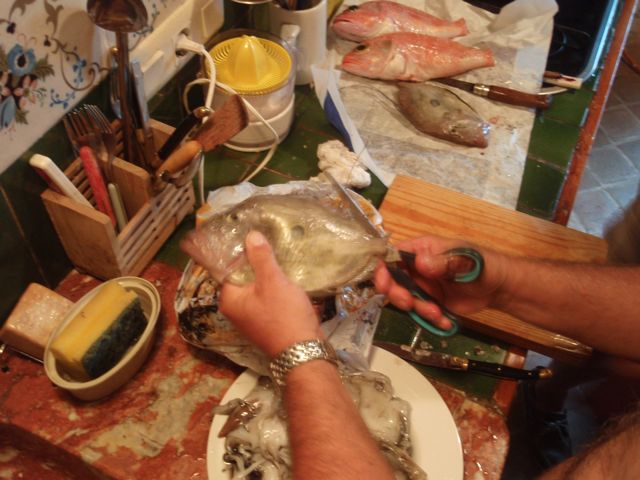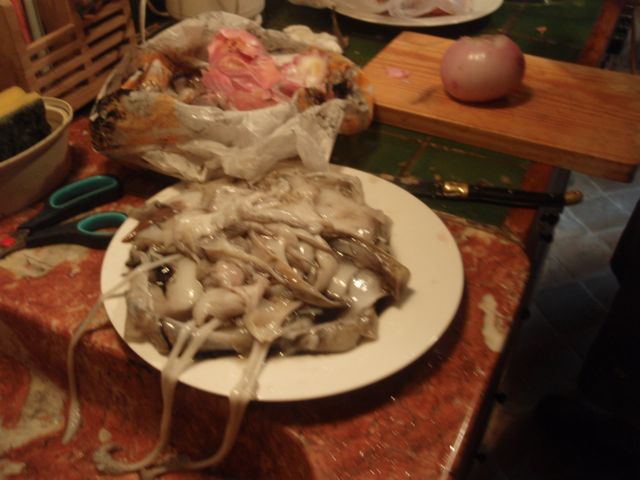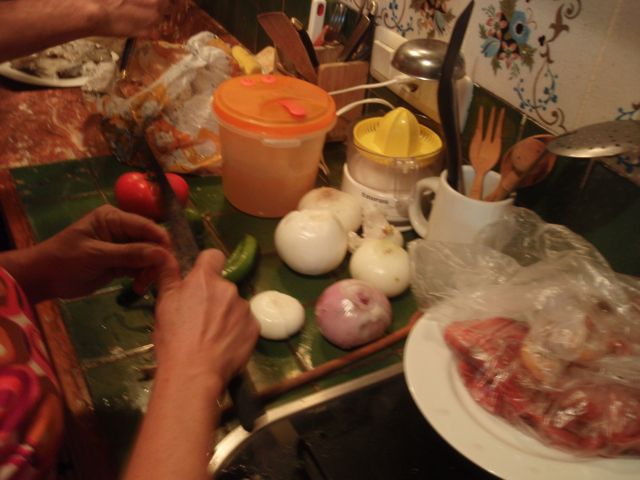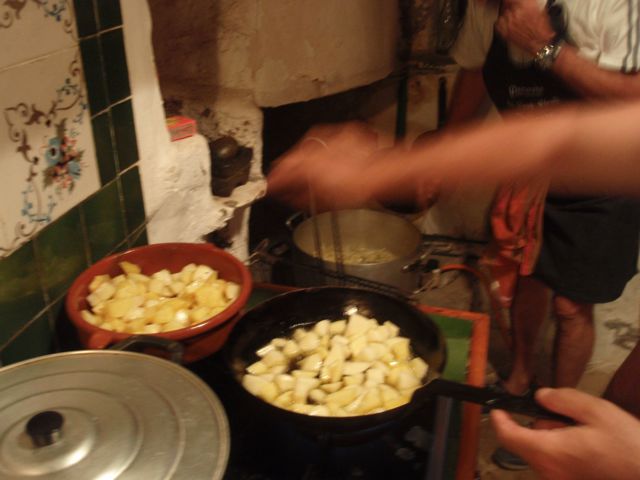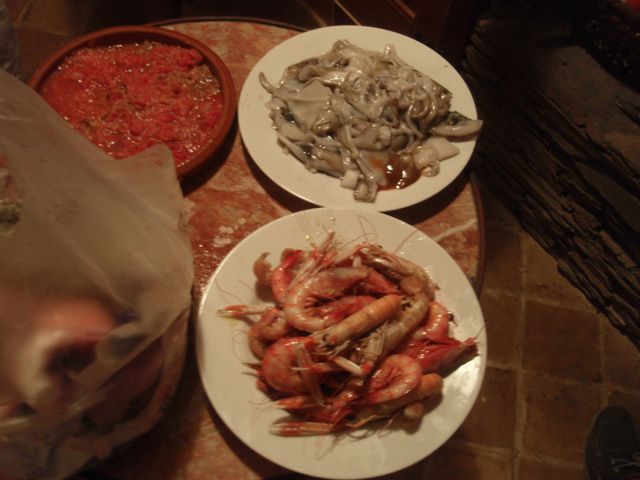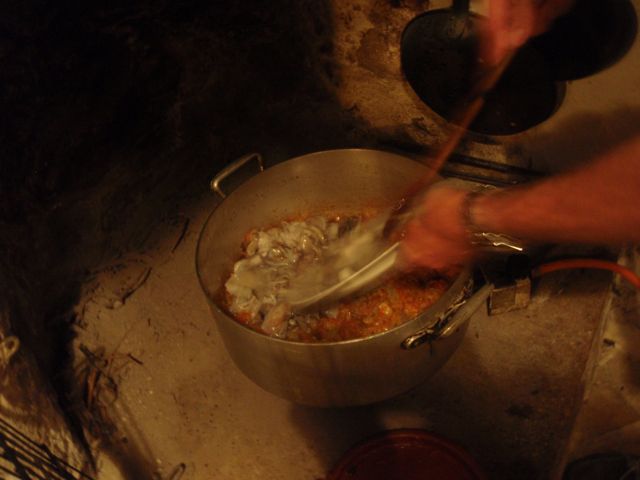SUQUET
1 kg/2 lb very fresh rascasse (scorpionfish), monkfish, rockfish, ocean perch, redfish, sea bass, halibut or a combination of any two of the above, cut into serving pieces (see note) flour
Salt and white pepper
Olive oil
2 Sprigs parsley, finely chopped
4 Cloves garlic, finely chopped
180 ml/6 fl oz Cognac of good-quality Spanish brandy
1 Onion, chopped
2 Tomatoes, seeded and grated (see note 2) or peeled, seeded and chopped
750 g-1 kg/1½ -2 lb Potatoes, peeled and sliced about 3 mm/⅛ inch thick
Fish stock
1 Slice fried bread (see note 3)
12 Almonds, blanched and roasted (see note 4)
Dredge the fish lightly in flour seasoned with salt and white pepper; then sauté it in a cassola, flameproof casserole or soup pot in a small amount of oil (adding more if necessary) until golden-brown.
Sprinkle the parsley and half the garlic over the fish, add brandy and carefully ignite. When the flames die out, remove the fish from cassola and set aside.
In the same cassola, adding more oil if necessary, make a sofregit (see note 5) of onion and tomatoes; then add potatoes and enough stock to cover. Cook covered for about 15 minutes, or until the potatoes are almost done.
Meanwhile, make a picada (see not 6) of remaining garlic, fried bread and almonds, moistened with a few drops of oil.
Stir the picada into the cassola when the stock has almost finished cooking; then add the fish and continue cooking until the fish is heated through. Salt and pepper to taste.
Note: If you are using monkfish, do not remove it from the cassola in step 2. Make the sofregit in a separate pan and add it to the cassola with the popatoes and the stock; then cook all ingredients together for 20 minutes. (Monkfish takes longer to cook than other varieties.)
Note 2: Slice a whole unpeeled tomato in half horizontally, squeeze out the seeds and then grate the fruit on the large holes of a four-sided grater, flattening it out with the palm of your hand as you go – and of course stopping when the peel is about to reach the holes. The result is a sort of instant coarse purée, perfect for cooking.
Note 3: Fried Bread. Use any good French or Italian bread, preferably “country-style” and not sourdough. To prepare bread for the picada remove the crusts, slice it about 1cm/½ inch thick, and brown it in plenty of hot olive oil. (The hotter the oil – up to a reasonable point, of course – the less of it the bread will absorb.) Drain the bread on paper towels, and allow it to cool and dry a bit before using.
Note 4: Almonds. Buy almonds pre-blanched and skinless, or blanch them by covering them with boiling water and letting them sit, off the heat, for two or three minutes, then skin by draining them, immersing them in cold water, and rubbing their skins off gently with your hands. (Some bits of almond skin may remain, but won’t adversely affect the picada.) Before use, almonds should be roasted in a 180˚ -200℃ oven until lightly browned. (Watch them closely so that they don’t burn, and shake the pan periodically to help them roast evenly. Dry almonds thoroughly with a clean towel before roasting if you have just blanched them.) Roasted almonds will keep for at least three of four weeks in the freezer, in a sealed plastic bag or other airtight container, and need not be thawed before use.
Hazelnuts. These needn’t be blanched, but should be roasted as above. If they still have their skins, rub them gently in a clean towel or between your palms after roasting, first allowing them to cool for 10 or 15 minutes. Hazelnuts, too may be frozen and used unthawed.
Pine nuts. These should always be bought already shelled and skinned and again roasted as above. (They will take less time to roast.)
Note 5: Sofregit. To make 250-375 ml/8-12 fl oz
Olive oil
3 onions, chopped (but not finely chopped)
6 tomatoes, seeded and grated or peeled, seeded and chopped
Cover the bottom of a cassola, flameproof casserole or large frying pan with at least 1 cm of oil, heat for several minutes then add the onions. Reduce the heat and cook uncovered until the onions have turned golden-brown and are beginning to caramelize, adding and cooking off a bit of water if desired. For a darker sofregit, the process may be continued until the onions reach the desired colour – but do not let them burn.
Add the tomatoes and mix well, then continue cooking until all liquid has evaporated, and the tomatoes have begun to “melt” into the onions. (at this point, add herbs if called for in specific recipe.)
If a specific sofregit recipe calls for garlic or other vegetables ) leeks, sweet pepper, etc. ), add them after the onions have wilted, adding more oil if necessary. Sofregit with or without tomatoes, may be made in larger quantities and stored in the fridge, covered with a thin layer of oil, in an airtight container, for two or three weeks at least. (it will last longer with tomatoes added, due to greater acidity.)
Note 6: Picada. To make 125 ml/4 fl oz
2 cloves garlic, finely chopped
15 almonds, blanched and roasted
15 hazelnuts, blanched and roasted
1 slice fried bread
¼ teaspoon salt
2 sprigs parsley, finely chopped
olive oil
Crush or grind all ingredients, except the parsley and oil, together with a mortar and pestle or in a spice mill.
Add the parsley and mash it into the mixture.
Add enough oil to barely cover the picada, then work it into the mixture slowly and thoroughly to form a thick paste.
Note: the picada may be finished in a food processor or blender if you wish, but it must be started in a mortar or spice mill (preferably the former) so that the nuts and bread are indeed pulverized together and not just finely ground.
Remember: the constituent elements of a good picada should not be recognizable in the finished dish, if the grainy texture of ground nuts or breadcrumbs is discernible, the picada has not been properly made.
ROMESCO SAUCE
To make 250-300 ml
3 dried ancho peppers “nyora – ñora” soaded in warm water for 1 hour, seeded and finely chopped.
1 small piece fresh Serrano or jalapeño pepper (1-2.5c. long, to taste), finely chopped
mild extra-virgin olive oil
2 tomatoes
6 cloves garlic, finely chopped
24 almonds, blanched and roasted
24 hazelnuts, roasted
2 sprigs parsley, finely chopped
2 slices fried bread
2 teaspoon good-quality red wine vinegar
salt
preheat the ove to 180 oC / 350 oF
Sauté the fresh and dried peppers briefly in a small amout of oil.
Bake the tomatoes in a lightly oiled baking dish for 10 minutes, then remove and cool.
With a pestle and mortar (preferably) or in a food processor or spice mill, make a thick paste of the garlic and sautéed peppers.
Work the nuts, parsly and fried bread into a mixture, mixing well.
Carfully peel and seed the tomatoes and coarsely chop.
Work the tomatoes into the mixture, then add vinegar and 2-3 tablespoons of oil and salt to taste. Mixture should be thickly liquid.
Suquet Côte Vermeille
Pour 4 personnes
2 ½ kg de poisson lave à l’eau de mer.
- Poissons pris à titre d’exemple :
- 1 baudroie de 1 Kg
- 1 rascasse
- 2 tranches de congre
- 1 grondin (L. Trigla lyra)
- 1 petit calmar
- 1 petite langouste (en plus) ;
- Autres ingrédients :
- 1 tête d’ail (Catalan « Cabota »)
- 2 cuillerées à soupe de farine
- 3 tomates de 100 gr chacune (ou 3 cuillerées à soupe de coulis)
- 6 cuillerées à soupe d’huile d’olive
- saindoux salé (généralement rance « sagit »)
- pommes de terre
- set, poivre, piment
– Retirer le foie de la Baudroie et le mettre à part ;
– Frotter la marmite avec une partie du saindoux (le reste sera placé au-dessus de la cuisson, et retiré cinq minutes avant de servir)
– couper l’ail très fin (non haché) ; le faire roussir dans l’huile d’olive ; lorsque l’ail est roussi, verser les tomates bien hachées.
– Verser la farine en pluie, progressivement, et ajouter un peu d’eau froide, pour éviter les grumeaux, (ceci à feu doux)
– Placer le Congre, et ajouter deux verres d’eau froide ; laisser cuire cinq minutes.
– Ajouter les pommes de terre coupées en rondelles ; finir de recouvrir d’eau froide ; laisser cuire cinq à six minutes de plus.
– Ajoute le reste du poisson ; assaisonner (sel, poivre, piment) ; placer le foie de la baudroie au-dessus de la cuisson, et le laisser saisir trois minutes, puis le retirer ; le placer dans un mortier et le broyer avec deux ou trois gousse d’ail et quatre anchois salés. Prendre une louche de sauce (qui continue a cuire dans la marmite) pour délayer cette pâte.
– Laisser cuire la bouillabaisse 25 minutes environ ; trois minutes avant de retirer la marmite (l’ouille) du feu, verser la préparation (foie, anchois, ail).
– Avant de servir, faire griller une tranche de pain par personne, la frotter avec de l’ail, la placer au fond de l’assiette ; servir les portions de bouillabaisse au-dessus.
